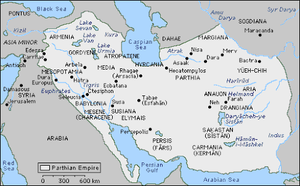After Alexander the Great invaded Persia, the Achaemenid Dynasty came to an end. Alexander's reign also only lasted from 336 BC - 323 BC and after his death (and lack of an heir) his entire empire was divided and finally succeeded by the Seleucid dynasty which existed from 312 BC to 63 BC, founded by Seleucus I Nicator. During the time of the Seleucid rule, however, the Parthian satrapy was conquered by Arsaces I who was the first king of Parthia, as well as the founder and eponym of the Arsacid dynasty of Parthia, ruling from 247 BC to 217 BC. The leader of the Parni, one of the three tribes of the Dahae confederacy, Arsaces founded his dynasty in the mid-3rd century BC when he conquered the satrapy of Parthia (now shared between Turkmenistan and Iran) from Andragoras, who had rebelled against the Seleucid Empire. He spent the rest of his reign consolidating his rule in the region, and successfully stopped the Seleucid efforts to reconquer Parthia. Due to Arsaces' achievements, he became a popular figure amongst the Arsacid monarchs, who used his name as a royal honorific. By the time of his death, Arsaces had laid the foundations of a strong state, which would eventually transform into an empire under his great-grand nephew, Mithridates I, who assumed the ancient Near Eastern royal title of King of Kings. Mithridates I of Parthia (r. c. 171–138 BC) greatly expanded the empire by seizing Media and Mesopotamia from the Seleucids. At its height, the Parthian Empire stretched from the northern reaches of the Euphrates, in what is now central-eastern Turkey, to eastern Iran. The empire, located on the Silk Road trade route between the Roman Empire in the Mediterranean Basin and the Han dynasty of China, became a center of trade and commerce.
The Parthians largely adopted the art, architecture, religious beliefs, and royal insignia of their culturally heterogeneous empire, which encompassed Persian, Hellenistic, and regional cultures. For about the first half of its existence, the Arsacid court adopted elements of Greek culture, though it eventually saw a gradual revival of Iranian traditions. The Arsacid rulers were titled the "King of Kings", as a claim to be the heirs to the Achaemenid Empire. There is unfortunately very limited historical records available on the Parthian Dynasty's inventions, but it is clear from remains that they maintained significant Greek cultural influences throughout the dynasty's existence. There are however a few "inventions" that were made famous by the Parthians.
One of their military branches was the light cavalry who was recruited from among the commoner class and acted as horse archers.They used composite bows and were able to shoot at enemies while riding and facing away from them; this technique, known as the Parthian shot, was a highly effective tactic While in real or feigned retreat their horse archers would turn their bodies back in full gallop to shoot at the pursuing enemy. The maneuver required superb equestrian skills, since the rider's hands were occupied by his composite bow. As the stirrup had not been invented at the time of the Parthians, the rider relied solely on pressure from his legs to guide his horse.
A signature feature of Parthian architecture was the iwan, an audience hall supported by arches or barrel vaults and open on one side. Use of the barrel vault replaced the Hellenic use of columns to support roofs. Although the iwan was known during the Achaemenid period and earlier in smaller and subterranean structures, it was the Parthians who first built them on a monumental scale. The earliest Parthian iwans are found at Seleucia, built in the early 1st century AD. Monumental iwans are also commonly found in the ancient temples of Hatra and perhaps modeled on the Parthian style. The largest Parthian iwans at that site have a span of 15 m (50 ft).
Perhaps the biggest accomplishment of the Parthians was an eager revival of the Persian culture that was nearly lost during the Hellenic times. Because of their desire to return to Iranian traditions, they gave rise to the Sassanid Dynasty who would end their reign, but lead Persia back to her roots for nearly 400 years. The Parthian Empire, weakened by internal strife and wars with Rome, was followed by the Sassanid Empire. Indeed, shortly afterward, Ardashir I, the local Iranian ruler of Persis (modern Fars Province, Iran) from Estakhr began subjugating the surrounding territories in defiance of Arsacid rule. He confronted Artabanus IV at the Battle of Hormozdgān on 28 April 224 AD, perhaps at a site near Isfahan, defeating him and establishing the Sassanid Empire. The Sassanians would not only assume Parthia's legacy as Rome's Persian nemesis, but they would also attempt to restore the boundaries of the Achaemenid Empire by briefly conquering the Levant, Anatolia, and Egypt from the Eastern Roman Empire during the reign of Khosrau II (r. 590–628 AD). However, they would lose these territories to Heraclius—the last Roman emperor before the Arab conquests.



